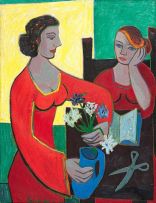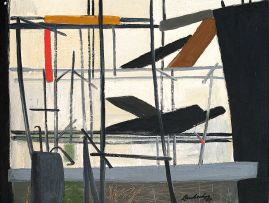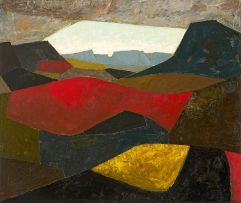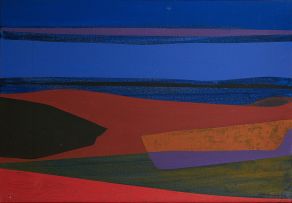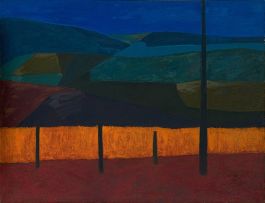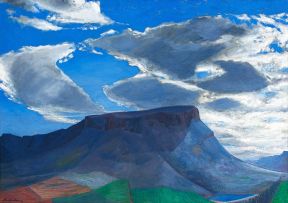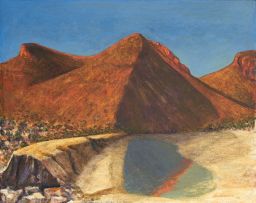Important South African & International Art, Jewellery and Decorative Arts
Live Auction, 12 October 2015
Important South African and International Art, Evening Sale
Incl. Buyer's Premium & VAT
About this Item
signed, dated 51 and indistinctly inscribed April; inscribed with the title, 'Paris March 1951' and the artist's address on the reverse
Notes
Much loved for his hard-edge abstractions portraying South Africa's rural landscapes, Erik Laubscher's early formalist paintings from his years in Paris nonetheless hold equal significance and are greatly prized by collectors. In 1950, Laubscher, an apprentice to Maurice van Essche who completed his basic art studies in London in the late 1940s, moved to Paris to further his tuition at the Académie Montmartre. Cubist painter Fernand Léger was the school's best-known faculty member, although in a 2008 interview Laubscher told how he fell under the influence of popular expressionist Bernard Buffet, a key figure in the voguish 'miserabilist' school of French postwar painting. Laubscher's infatuation with Buffet, who was a year his junior, was short-lived: "In the last few paintings I did in Paris there was a big shift towards more colour, away from the subdued, Buffet-type greys and greens of the New Realists," explained Laubscher.1
This work is exemplary of Laubscher's newfound optimism and confidence as a painter. It portrays two female figures, one contemplatively seated in front of an open book, the other standing and involved in active labour, arranging cut flowers. The symbolist connotations, notably of the scissors and flowers in relation to the attractive young women, formed an important aspect of Laubscher's early work, and would in fact "linger as a subtext" throughout his oeuvre. 2 This fine composition suggests how Laubscher quickly synthesised the various influences of his French education. The impact of Braque's reduced still life compositions and flattened dimensionality is here married with an understanding of the neo-classical figuration of Picasso and Léger. In the manner of Matisse's 1905 portrait of his wife, Amelie, a canonical work marked by its rudimentary construction and planes of colour, Laubscher's geometrically proportioned composition is a marvel of colour and mood.
Two months after painting this work, Laubscher held a one-man show at Bar Vert, a well-known Left Bank café in Paris frequented by the likes of Octavio Paz and Antonin Artaud. While the notices were positive, Laubscher did not sell any work.3 Upon returning to South Africa, Laubscher's talents were immediately recognised by Walter Battiss, then an influential critic. Writing in London-based art magazine The Studio, Battiss remarked: "Cape Town is still the home of Impressionism, but the new and compelling work of Erik Laubscher … at a recent Art Club exhibition is a challenge to stale ideas in the Cape."4 He also praised Laubscher's ability to "paint big canvases with satisfying assurance". The jouissance and vigour that marked Laubscher's early work, of which this is a fine example, was no flash in the pan, as his successful career as a painter and later educator bear out.
1. 'Erik Laubsher in conversation with Baylon Sandri', in Hans Fransen (2008) Erik Laubscher: A Life in Art, Cape Town: SMAC. Page 261.
2. Elza Miles, 'Knitting in Paint: A Spiritual Quest,' in Hans Fransen, op.cit. Page 272.
3. Hans Fransen, op.cit. Page 23.
4. Walter Battiss, 'New art and old art in South Africa: Twenty-one ideas', The Studio, July 1952, page 70.
Literature
Hans Fransen. ( 2009) Erik Laubscher: A Life in Art, Stellenbosch: SMAC Art Gallery. Page 270, 272 and illustrated in colour on page 271.

